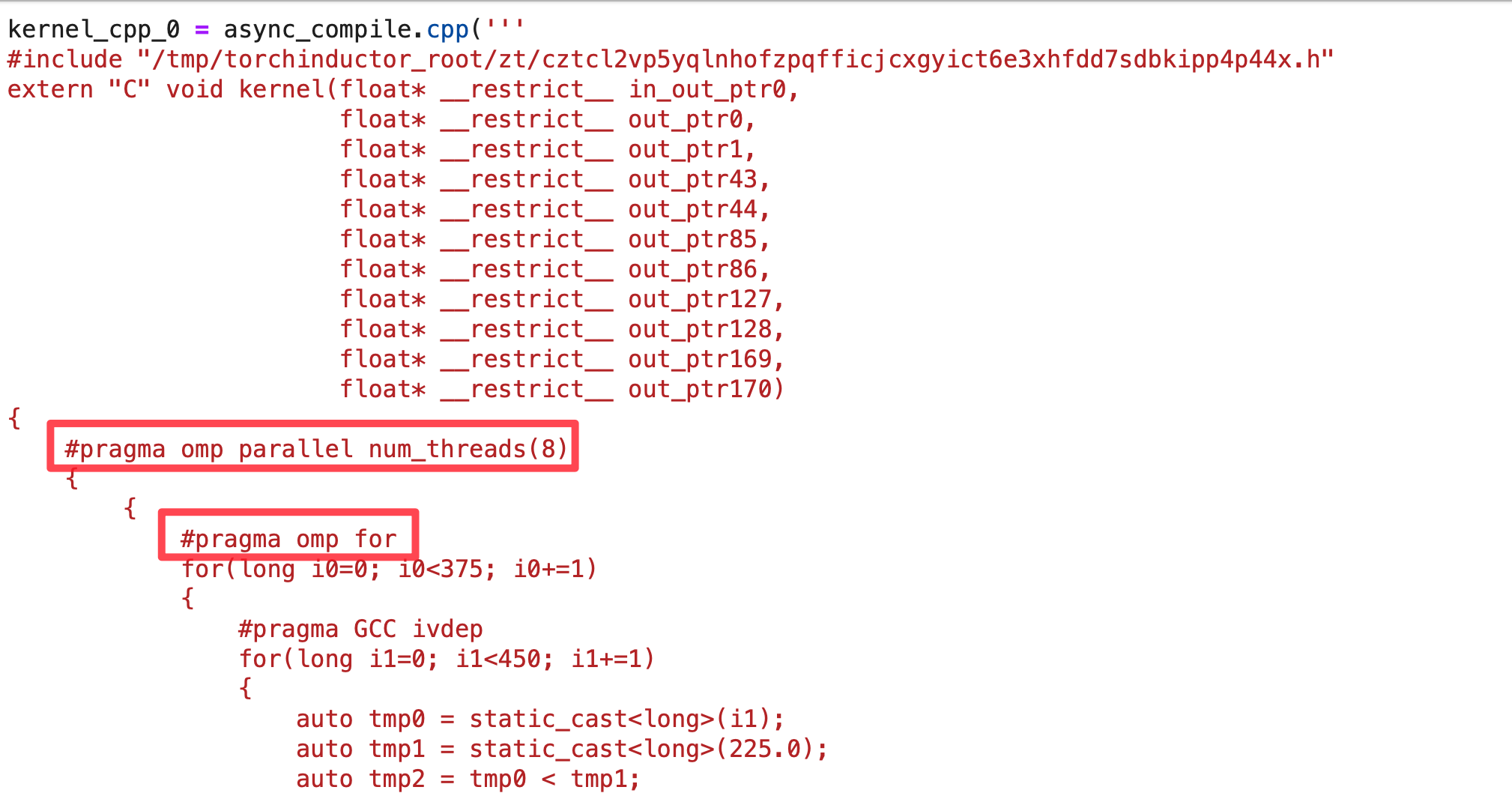Benchmarking Modular Mojo🔥 and PyTorch torch.compile() on Mandelbrot function
Last week, Modular - an startup co-founded by Chris Lattner (of LLVM, Swift, MLIR fame), announced a brand new high-performance language called Mojo🔥. Mojo🔥 looks and reads like Python but that’s only on the surface, underneath the familiar Python syntax Mojo uses it’s own JIT and AOT compilation process to accelerate Python code. Although Mojo doesn’t fully support all of Python today, according to Mojo docs, over time Mojo is expected to become a superset of Python. PyTorch's got some Mojo🔥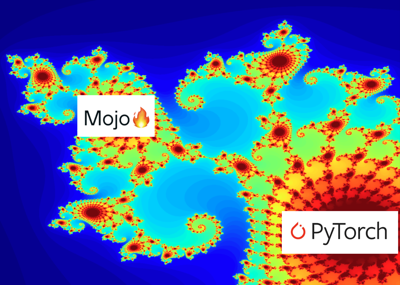
And my favorite feature of PyTorch is the new torch.compile() API introduced in PyTorch 2.0 that can accelerate arbitrary functions (with limitations) written using the PyTorch API. It takes PyTorch highlevel API, optimizes it and generates C++ or GPU code to improve it’s performance. I’ve discussed torch.compile() in great detail in my blog post, and I highly recommend reading it if you want to learn about how PyTorch compiler does operator fusion and CPU/GPU code-generation:
In this blog post I want to discuss relative performance between Mojo🔥 and PyTorch, and I picked the Mandelbrot example that Jeremy Howard (or FastAI fame) demoed during the Modular keynote. I reimplemnted Mojo’s Mandelbrot example in PyTorch to compared it’s performance with Mojo. Before I get into the code, here are the results.
Summary: Mojo is fast! and PyTorch is no slouch either!
| Language/Framework | Mandelbrot execution (200 iterations) | System |
|---|---|---|
PyTorch GPU torch.compile() | ~165 μs (micro seconds) | Intel Core i7-9700K CPU @ 3.60GHz + NVIDIA Titan V |
| Mojo CPU | ~2.6 ms | Mojo Playground: Intel Xeon Platinum 8375C CPU @ 2.90GHz |
PyTorch CPU torch.compile() | ~9 ms | Intel Core i7-9700K CPU @ 3.60GHz |
| PyTorch GPU | ~15 ms | Intel Core i7-9700K CPU @ 3.60GHz + NVIDIA Titan V |
| PyTorch CPU | ~50 ms | Intel Core i7-9700K CPU @ 3.60GHz |
| PyTorch Apple M2 MPS | ~70 ms | Macbook Pro M2 Apple Silicon + 30-Core GPU + 16-Core Neural Engine |
| Python/numpy | ~152 ms | Intel Core i7-9700K CPU @ 3.60GHz |
Interesting observations
- Mojo is the fastest CPU implementation
- PyTorch GPU with
torch.compile()generates a fused cuda kernel making it the fastest on GPU - PyTorch CPU with
torch.compile()which generates fused C++ code is still faster than PyTorch GPU without compilation
It should come as no surprise that PyTorch generated custom fused kernel for Mandelbrot function running on GPU is indeed faster than Mojo CPU, it’s not even a fair comparision. PyTorch CPU is only slightly slower, but makes up for performance with better usability. Mojo is harder to use and I’m positive the UX will improve over time.
Benchmarks and caveats
This is not a scientific benchmark test. This is a rather crude, and hacked-together-in-a-day example that should illustrate the performance differences and coding approaches, so take it with a grain of Sodium Chloride.
My naive testing methodology:
- I use Jupyter’s native
timeitwith10repeats to benchmark and report mean and variance. - For GPU, I call
torch.cuda.synchronize()before measurement to ensure that the kernel is fully executed. - This code example also benchmarks tensors/arrays creation which is in the body of the function, which migh not be a feature that arises in real-world scenarios.
- I don’t measure the compilation time for PyTorch 2.0 and that does take a lot of time to generate loop-unrolled C++ code for CPU and NVPTX for GPU.
Hardware differences
Mojo is not open-source (yet), and the only way to run it is on the early access Mojo Playground which has a different configuration compared to my desktop running PyTorch. For the Apple M2 benchmark I also use a MacBook Pro laptop for M2 testing. Suffice to say, this is not a fair comparison. Hardware details:
- PyTorch on Desktop
- CPU: Intel Core i7-9700K CPU @ 3.60GHz with 8 cores
- GPU: NVIDIA Titan V
- PyTorch on Mac
- Apple MacBook Pro with M2 Apple Silicon
- Mojo🔥 on Mojo Playground
- Intel Xeon Platinum 8375C CPU @ 2.90GHz with 32 cores
Why is PyTorch so much faster than Python/Numpy on CPU?
PyTorch is faster than Python/Numpy because the higher level PyTorch API calls highly optimized C++ routines implemented in the ATen library. These routines are eagerly evaluated, which means that each PyTorch API call is executed immediately which adds some function call overhead with every API call. To address this, PyTorch 2.0 introduced a compilation API called torch.compile() which takes eager PyTorch code, optimizes it and generates C++ code with OpenMP pragmas for parallelization on CPU or generates GPU code using OpenAI Triton. This is similar to what Numba does for Python code, but PyTorch 2.0’s torch.compile() is much more powerful because it can fuse multiple PyTorch API calls into a single kernel, which reduces function call overhead and improves performance.
I’ve discussed this in detail in my PyTorch 2.0 blog post, but here is a screenshot of what the automatically generated fused kernels for C++ for CPU and OpenAI Triton for GPU look like for Mandelbrot function
Baseline: Benchmarking Python/Numpy
Let’s start with a baseline. Here’s the Python/Numpy implementation of Mandelbrot function. I’ve also included a function to plot the Mandelbrot set using matplotlib. We’ll later modify this function to use PyTorch.
| |
Output:
With a baseline established let’s compare the performance of PyTorch and Mojo.
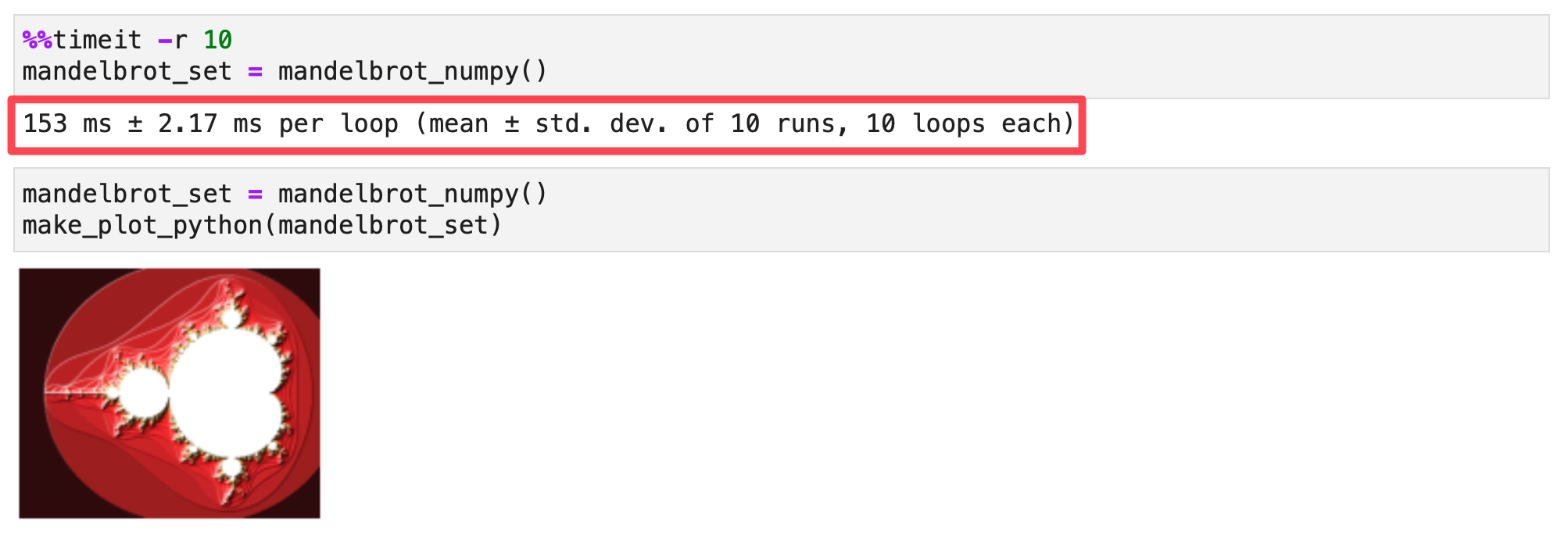
Benchmarking Mojo on the Mojo playground
This comparision is a bit unfair because Mojo🔥 playground has a 32 core Xeon CPU, but I only have a modest 4 year old 8 core desktop CPU. The clock frequency, memory bandwidth and cache sizes and number of cores are all different, but I can’t install PyTorch on Mojo playground so this is the best I can do for comparision for now.
At the bottom of this notebook, I add these few lines of code to measure the execution time of the mandelbrot function.

| |
Output
I found it difficult to benchmark Mojo, because Python benchmarking tools don’t work very readily. I ran the above code several times to ensure that the results are consistent.

Benchmarking PyTorch CPU
To update our mandelbrot function from numpy implementation to PyTorch implementation I made the following small changes
- replace
npwithtorch - add
device=deviceto the tensor creation calls, this allows us to pass the appropriate CPU, GPU or Apple MPS device to PyTorch.
Updated mandelbrot function:
| |
Now let’s call our mandelbrot_pytorch function with device='cpu'

Benchmarking PyTorch CPU with torch.compile()
You can compile PyTorch functions using torch.compile() and TorchInductor will optimize and generate C++ code with OpenMP pragmas for parallization. This will significantly improve the performance of the function. All of this happens under the hood when you run the code below, but you can pass an additional argument options={'trace.enabled':True} to see the generated code. I discuss this is further detail in my PyTorch 2.0 blog post:
Let’s compile our mandelbrot function for CPU backend:
| |
Output

The generated C++ code looks like this
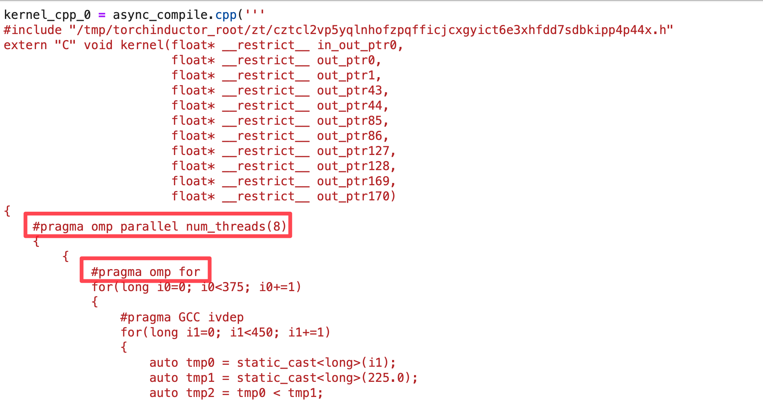
Benchmarking PyTorch GPU
| |
Output
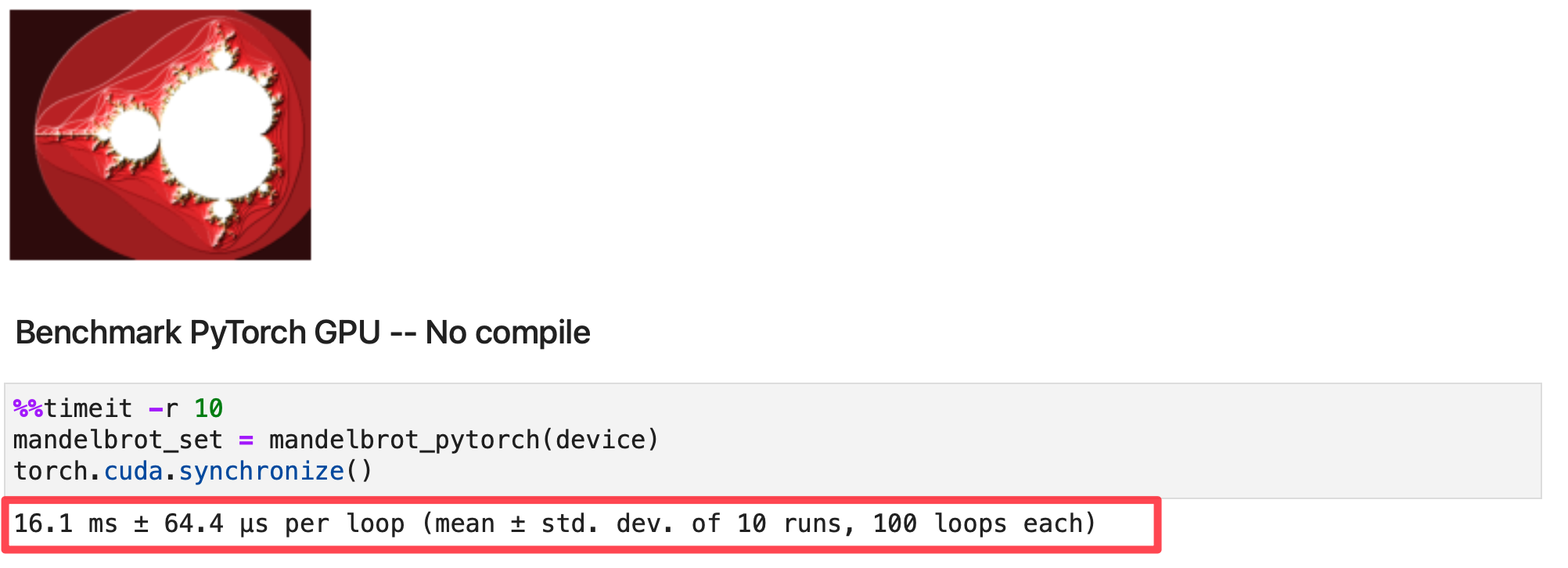
Benchmarking PyTorch GPU with torch.compile()
| |

The generated OpenAI Triton code which gets compiled to NVPTX for GPUs, looks like this
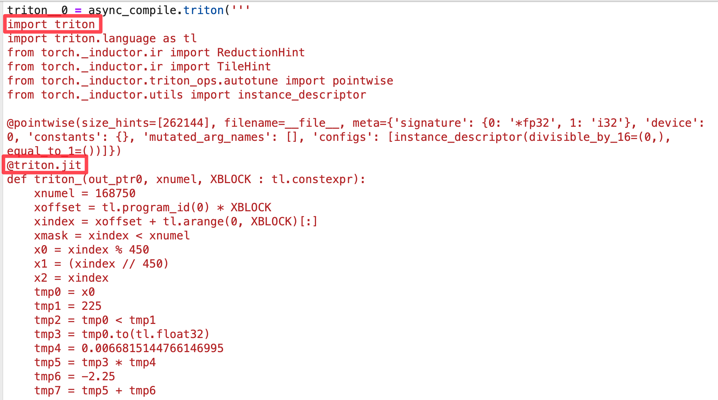
Benchmarking PyTorch Apple M1/M2 Silicon with MPS support

Conclusion
That’s it folks! I hope you enjoyed this quick comparision of PyTorch and Mojo🔥.
Mojo is fast, but doesn’t have the same level of usability of PyTorch, but that may just be just a matter of time and community support. PyTorch’s one-two punch combo of eager mode with high-level Tensor API and compilation with torch.compile() is a powerful combination today. However, the PyTorch ecosystem is also quite fragmented with multiple code paths for different accelerators: TorchInductor (GPUs, CPUs), XLA (TPU, AWS Tranium/Inferentia), custom bindings/bridges (Intel Habana, MPS), and some accelerators like GPUs implement all paths. This leaves the end user and hardware vendors in a dilemma.
One of the main benefit of Mojo that I see is the ability to write OpenAI Triton style kernel code in the Python language with fast or faster then C++ performance. This would make supporting custom ops for inference easier. We’re certainly living in an exciting times for AI Infra, AI accelerators and AI frameworks. Maybe we’re at the cusp of another LLVM moment but for AI.
If you enjoyed reading this, check out my other blog posts on Medium or reach out to me on social media, links are on the homepage. Cheers!

